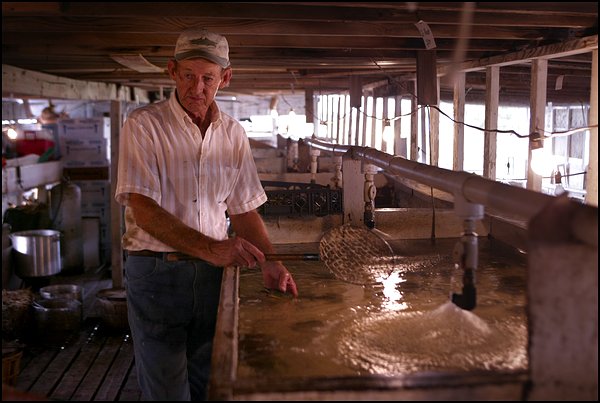August 20, 2004
8/20 - Seppo Nightmare: The Chesapeake Bay chokes again
Australians are fond of calling Americans "Seppos," which is short for "septic tanks," which kind of rhymes with "yanks" in their twisted little minds. According to waterman Elmer Evans, of Smith Island, "That's what the Chesapeake Bay is now, a big septic tank." So if the Gulf of Mexico is the toilet of America, and the Chesapeake Bay is the septic tank, what does that make San Francisco Bay?
Probably not a laughing matter for people of Maryland and Northern Virginia. It's that time of year again when the No Oxygen zone ominously slides beneath the waters of the Chesapeake Bay, suffocating all the marine life in its path. "It rolls in like a fog," Evans says. Over the past 20 years its become a regular phenomenon which keeps getting worse. Here is an excellent in-depth article in the Washington Post that tells of the widespread frustration with the sad state of the Bay (you must register to read the full article or see an exerpt below).

Elmer Evans feels like a true blue Seppo.
Bay's 'Bad Water' Churns Unease
Summer's Low-Oxygen Zones Leave Sea Life, Locals at a Loss
By David A. Fahrenthold
Washington Post Staff Writer
Monday, August 16, 2004; Page B01
NEAR POINT NO POINT, CHESAPEAKE BAY -- The bad water shifts like fog under the surface.
Some days, there's no sign of it in this shallow part of the bay off St. Mary's County, where Buddy Evans puts out his pots to catch blue crabs. Other days, he pulls up the pots and finds all the crabs dead inside.
"It's just like a fog. It rolls in, it rolls out," said Evans, a 37-year-old waterman from Smith Island.
What Evans and others call "bad water" has been robbed by algae of its dissolved oxygen, which fish and crabs need to breathe. Scientists blame man-made pollutants -- animal manure, suburban lawn-care products and treated sewage -- that act like underwater fertilizer for the algae.
For 20 years, this kind of pollution has been recognized as the most pervasive of the Chesapeake's many troubles. But years of effort to curb it has made little change: Last summer, when heat and high rainfall made the algae bloom heavily, about 40 percent of bay water lacked adequate oxygen, according to the Environmental Protection Agency's Chesapeake Bay Program.
The season for bad water has come again. And in one recent week, a tour of the bay and its tributaries revealed a tide of frustration.
Aug. 2: University of Maryland
Robert J. Diaz, a professor at the Virginia Institute of Marine Science, was talking to a room of scientists gathered for a dissolved-oxygen conference. His presentation included one slide that summed up the day's message: "When you can't breathe, nothing else matters."
"Humans have not screwed up any other measurement" of the Chesapeake's health, Diaz told the group, "as much as oxygen."
The process of oxygen depletion starts in the bay's tributaries, including the Potomac, Severn and Susquehanna rivers, the scientists said. Rain washes animal manure and lawn fertilizer into creeks and rivers, and sewage plants dump treated waste. Even air pollution, released by power plants hundreds of miles away, can land on the water.
Through those kinds of pollution, the water absorbs large amounts of nitrogen and phosphorus. These nutrients feed algae blooms that choke off light to underwater grasses. And when the algae die, they decompose in a way that consumes large amounts of dissolved oxygen.
The result is bad water. How much of it depends on rainfall; in a dry year such as 2002, less runoff occurs, and the algae decline. The bad water is more common in the deep channels of the middle bay, scientists said, where it doesn't mix with oxygen from the air. But winds or water currents can move it into shallower areas where crabs and fish are plentiful.
Because the bad water doesn't stay in one solid mass, scientists at this gathering said they don't like the term "dead zone" -- used by the private Chesapeake Bay Foundation to describe the low-oxygen areas.
In addition, they said, bad water isn't always dead: In some areas, there is enough oxygen for more resilient species such as crabs and oysters to survive.
"It's sort of like you and I going up to the top of Mount Everest," said Rich Batiuk of the Chesapeake Bay Program. "We can survive up there. But darn, it's hard to breathe."
Posted by Randy Olson at August 20, 2004 09:00 AM